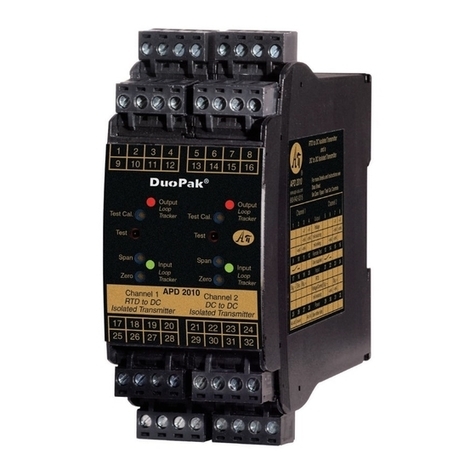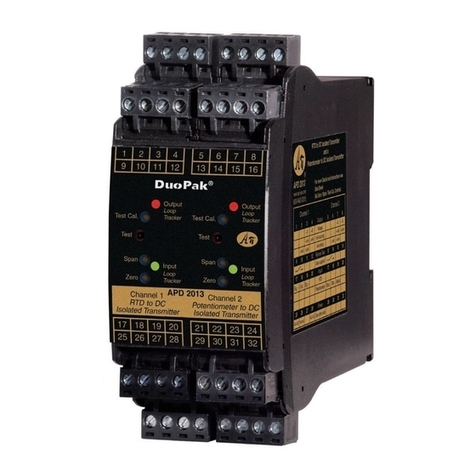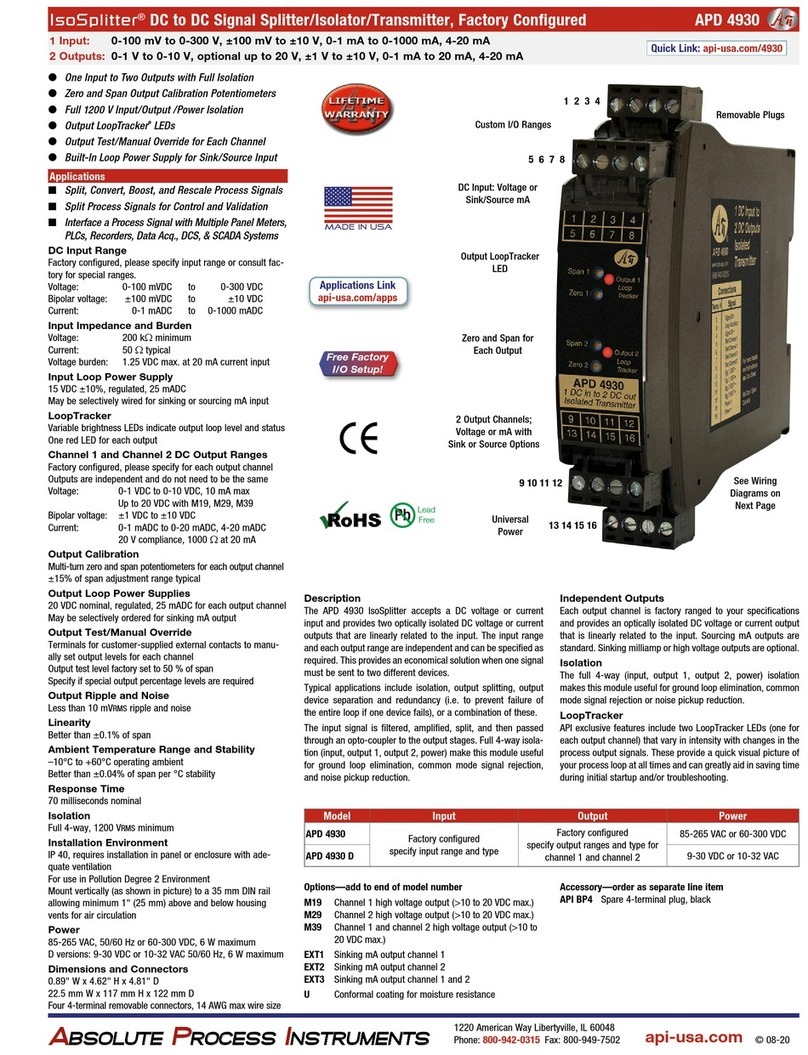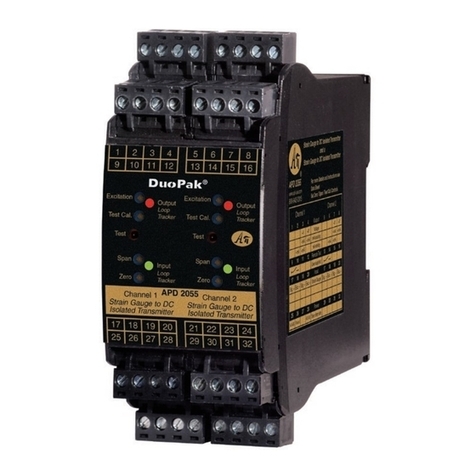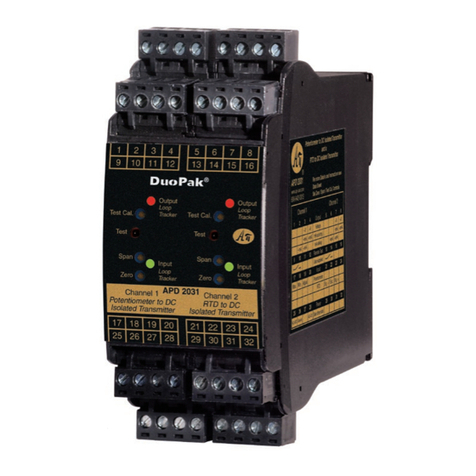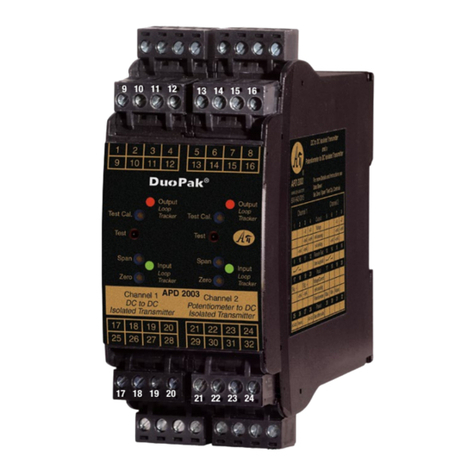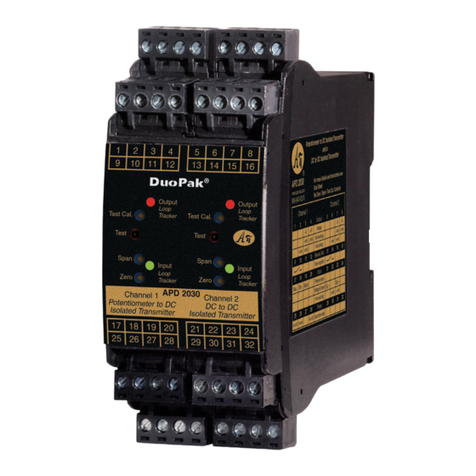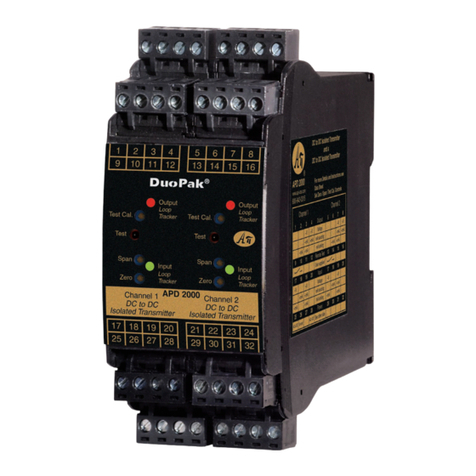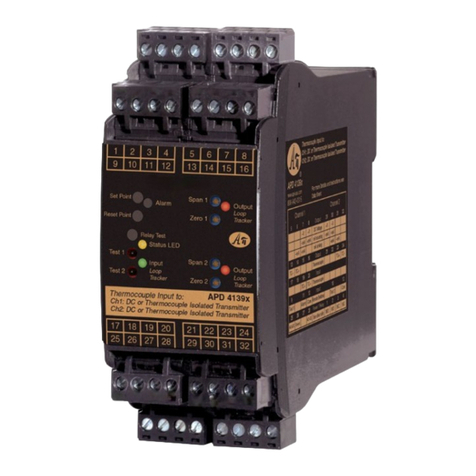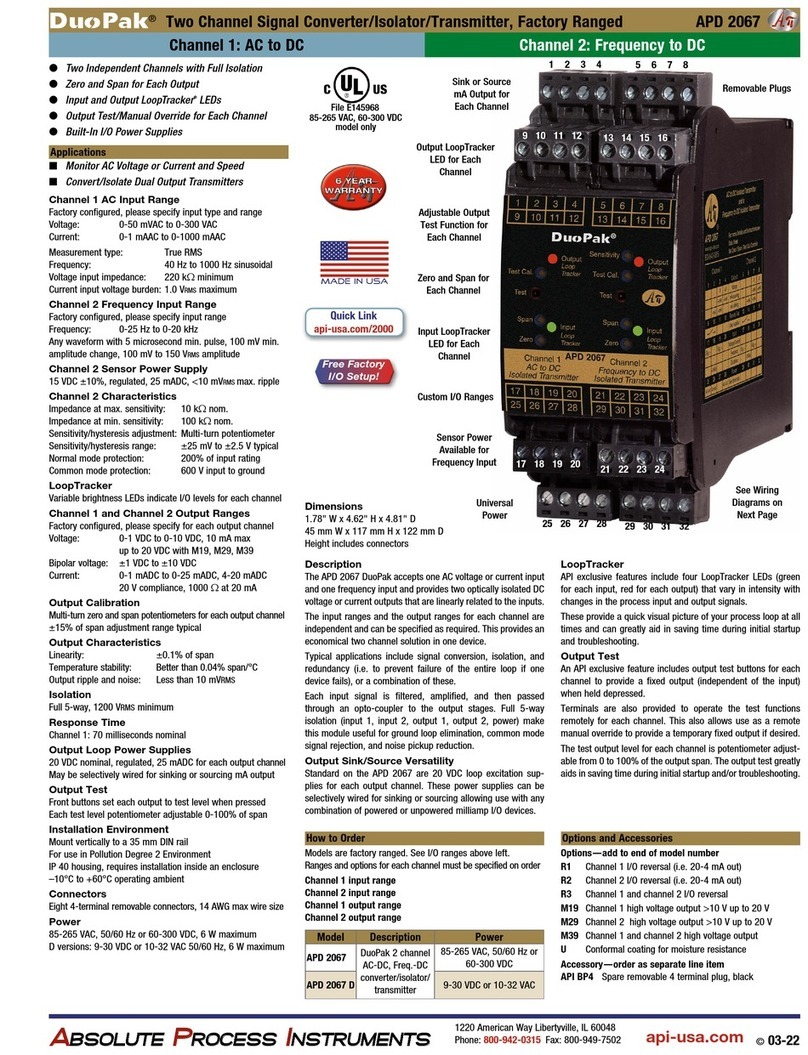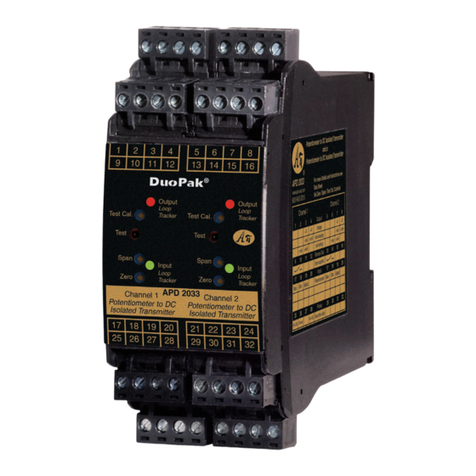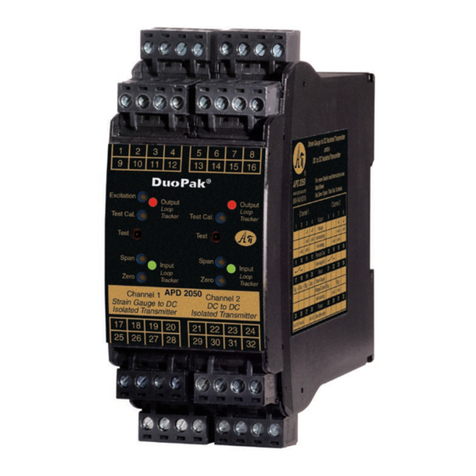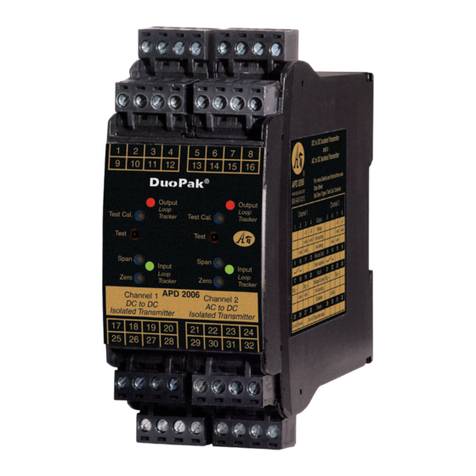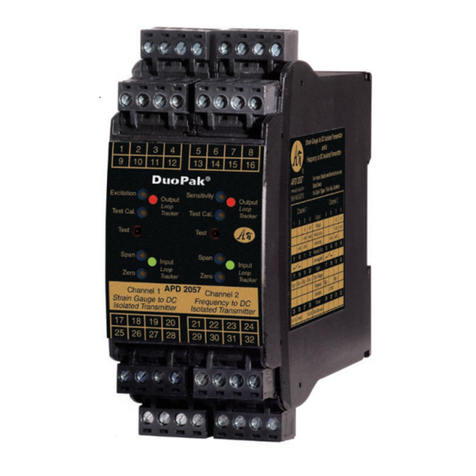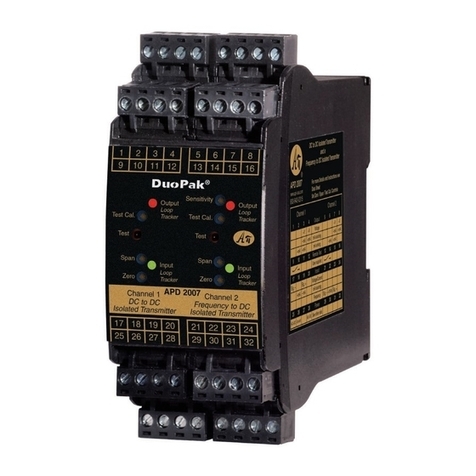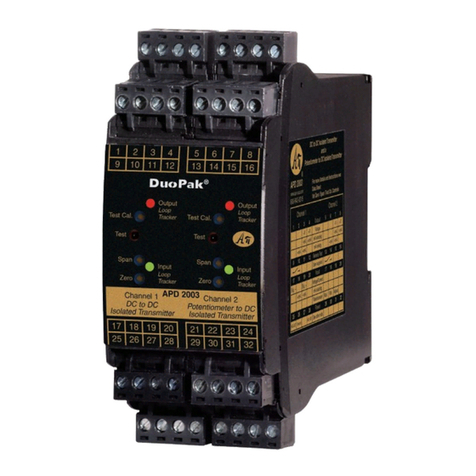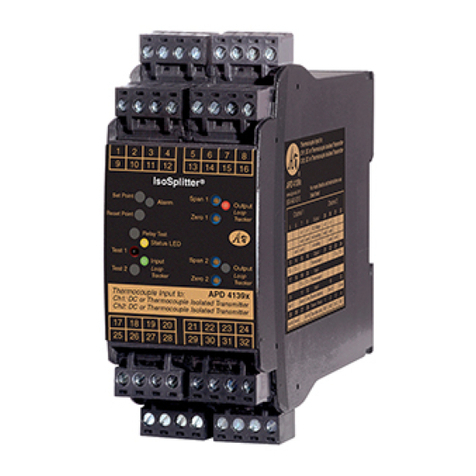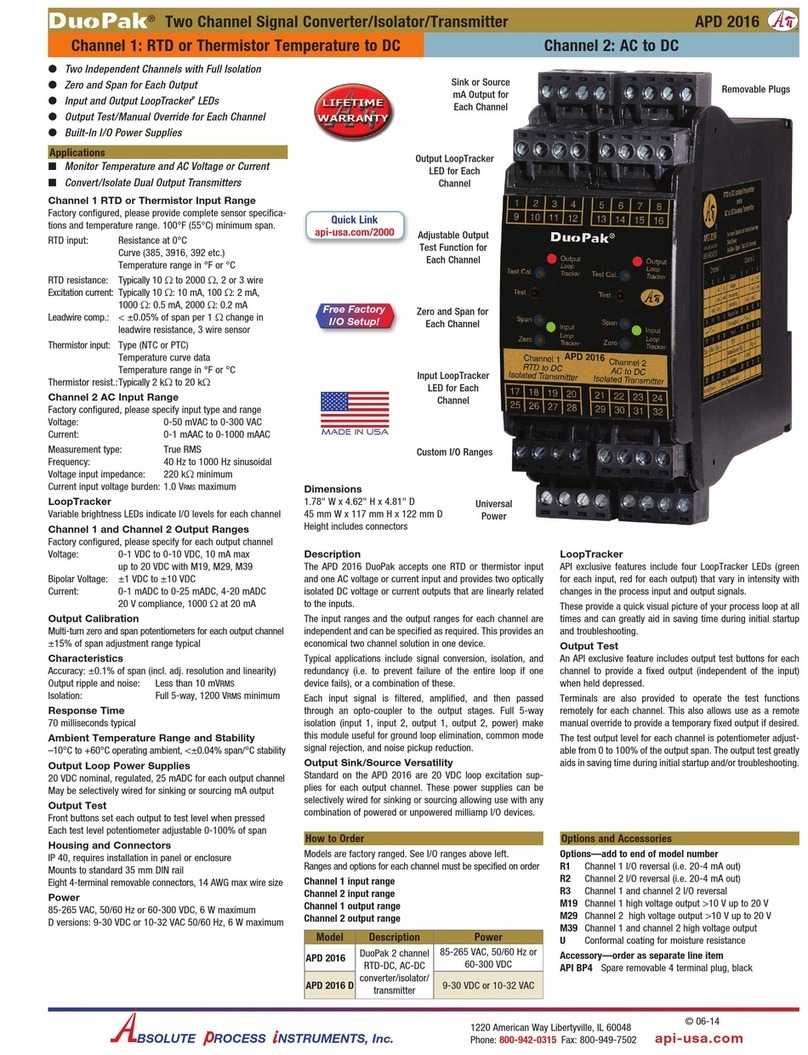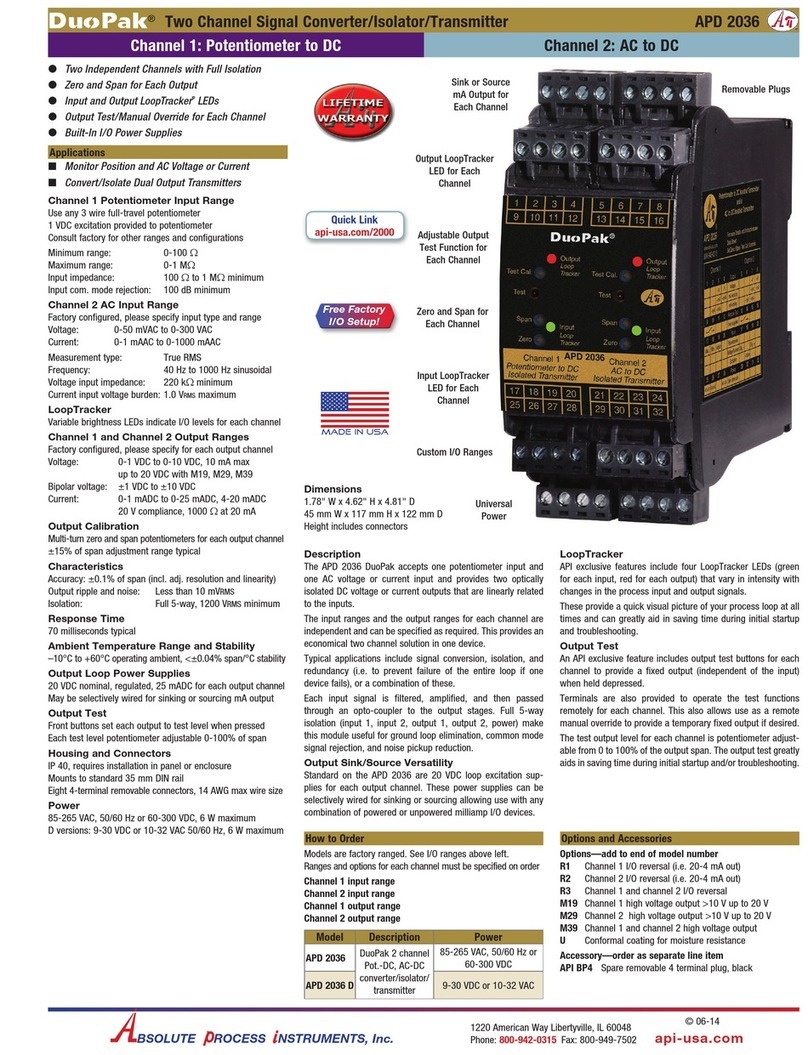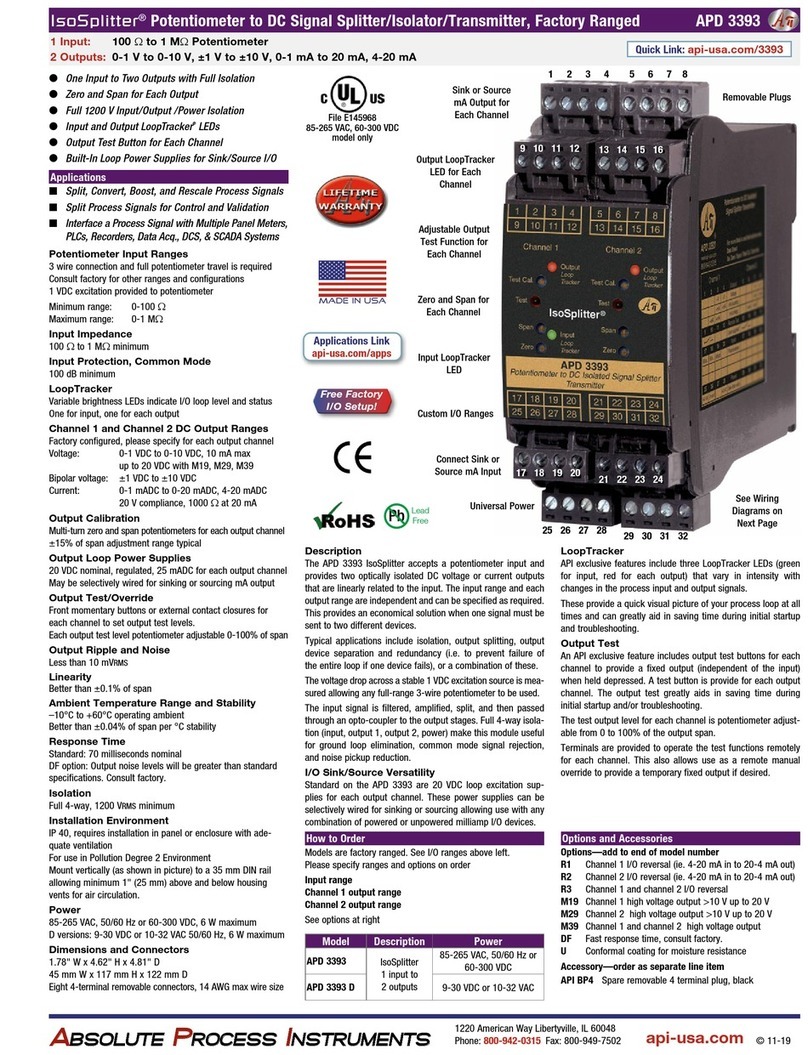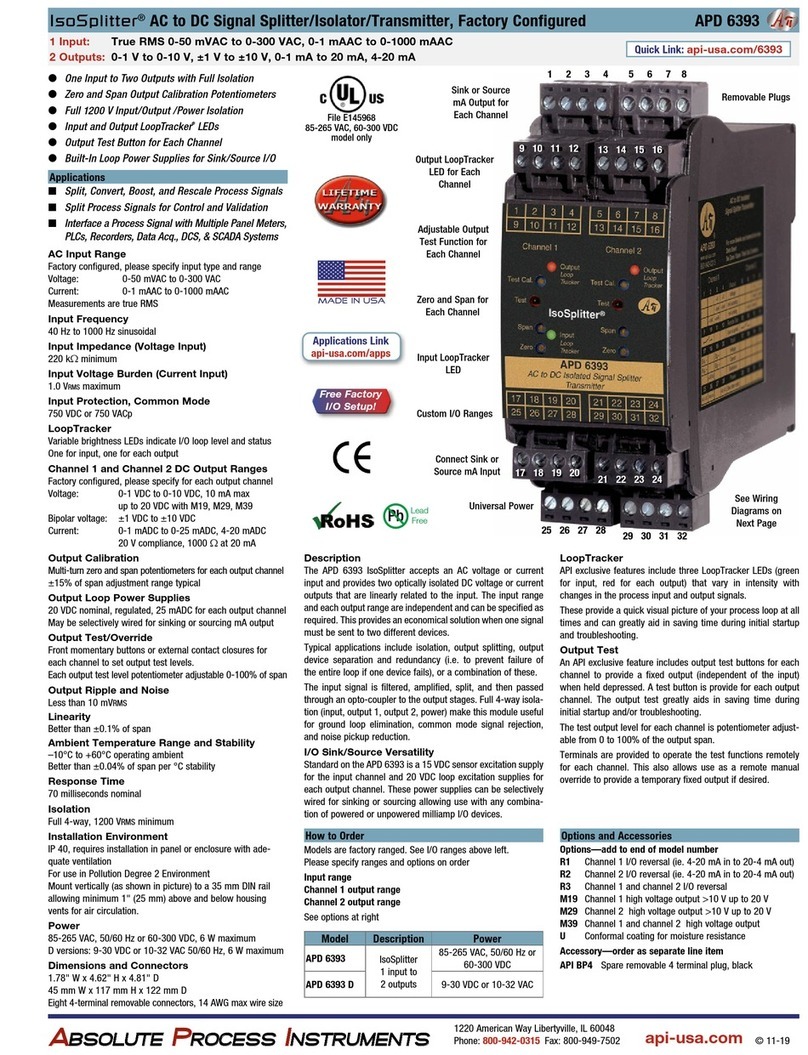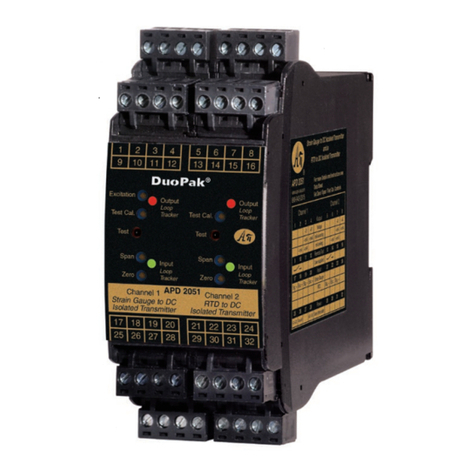
api-usa.com
1220 American Way Libertyville, IL 60048
Phone: 800-942-0315 Fax: 800-949-7502
BSOLUTE ROCESS NSTRUMENTS, Inc.
Instructions APD 2005
Calibration
Front-mounted Zero and Span potentiometers for each channel
can be used to compensate for load and lead variations.
1. Apply power to the module and allow a minimum 30 minute
warm up time.
2. Using an accurate voltmeter on terminals 22 and 24 adjust
the excitation voltage potentiometer to the strain gauge
manufacturer's recommended value.
3. Using an accurate calibration source, provide an input to the
module equal to the minimum input required for the application.
4. Using an accurate measurement device for the output,
adjust the Zero potentiometer for the exact minimum output
desired. The Zero control should only be adjusted when the
input signal is at its minimum. This will produce the cor-
responding minimum output signal. Example: for 4-20 mA
output, the Zero control will provide adjustment for the 4 mA
or low end of the signal.
5. Set the input at maximum, and then adjust the Span pot for
the exact maximum output desired. The Span control should
only be adjusted when the input signal is at its maximum.
This will produce the corresponding maximum output
signal. Example: for 4-20 mA output, the Span control will
provide adjustment for the 20 mA or high end of the signal.
6. Repeat adjustments for both channels for maximum accuracy.
Output Test Function
When the Test button is depressed it will drive the output with a
known good signal that can be used as a diagnostic aid during
initial start-up or troubleshooting. When released, the output
will return to normal.
Each Test Cal. potentiometer is factory set to approximately
50% output. Each can be adjusted to set the test output from
0 to 100% of the output span. Press and hold the Test button
and adjust the corresponding Test Cal. potentiometer for the
desired output level.
They may optionally be externally wired for remote test opera-
tion or a manual override. See wiring diagram at right.
Operation
The APD 2005 accepts one DC voltage or current input and
one strain gauge input and provides two optically isolated DC
voltage or current outputs that are linearly related to the inputs.
Green LoopTracker®input LEDs provide a visual indication that
each signal is being sensed by the input circuitry of the module.
They also indicates the input signal strength by changing in
intensity as the process changes from minimum to maximum.
If an LED fails to illuminate, or fails to change in intensity as the
process changes, check the module power or signal input wiring.
Two red LoopTracker output LEDs provide a visual indication
that the output signals are functioning. They become brighter
as the input and each corresponding output change from
minimum to maximum.
For a current output the red LED will only light if the output loop
current path is complete. For either current or voltage outputs,
failure to illuminate or a failure to change in intensity as the
process changes may indicate a problem with the module
power or signal output wiring. Note that it may be difficult to
see the LEDs under bright lighting conditions.
APD 2005
Channel 1 Channel 2
DC to DC Strain Gauge to DC
Isolated Transmitter Isolated Transmitter
Test Cal.
Span
Zero
Test
Output
Loop
Tracker
Test Cal.
Span
Zero
Test
Output
Input
Loop
Tracker
Loop
Tracker
Input
Loop
Tracker
Channel 1 Channel 2
®
Excitation
1413 15 16109 11 12
External
Contacts
for Test
Function
– + 20V – + 20V
mA
Device 2
Ri
mA
Device 1
Ri
65 7 821 3 4
Current
Sourcing
Output
Ch. 1 Ch. 2
Voltage
Output
– +
Voltage
Device 1
– +
Voltage
Device 2
21 3 4
Ch. 1 Ch. 2
65 7 8
– +
mA
Device 2
Ri
Loop
Power
Source 2
– +
+–
mA
Device 1
Ri
Loop
Power
Source 1
Current
Sinking
Output
Ch. 1 Ch. 2
21346578
+–
28 Power AC or DC –
26 Earth Ground
25 Power AC or DC +
2625 27 28
1817 19 20
+15V –
mA
Xmtr 1
Ri
Ch. 1
Current Sourcing Input
1817 19 20
+
–
mA
Xmtr 1
Ri
Loop
Power
Source 1
+–
Ch. 1
Current Sinking Input
1817 19 20
Voltage
Xmtr 1
– +
Ch. 1
Voltage Input
Electrical Connections
WARNING! All wiring must be performed by a qualified electri-
cian or instrumentation engineer. Consult factory for assistance.
Avoid shock hazards! Turn signal input, output, and power off
before connecting or disconnecting wiring.
Polarity must be observed for signal wiring connections. If the
input and/or output do not function, check wiring and polarity.
Each product is factory configured to your exact input and
output ranges as indicated on the white serial number label.
Check label for module operating voltage to make sure it
matches available power. The power supplies are fuse protect-
ed and the unit may be returned to API for fuse replacement.
Outputs
For milliamp ranges determine if your devices provide power
to the current loop or if the loop must be powered by the APD
module. Typical voltage may be 9-24 VDC at your device's
terminals if it provides power to the loop.
2221 23 24
Excitation +
Signal +
Strain
gauge
Signal –
Excitation –
See manufacturer's
specifications for
wiring designations.
Shield wires should
be grounded at one
end only.
Device for Output Channel 1 Terminal Terminal
Measuring/recording device accepts a
voltage input. 3 (–) 4 (+)
Measuring/recording device has
an unpowered or passive mA input.
APD module provides the loop power.
3 (–) 4 (+20 V)
Measuring/recording device has a mA
input and powers the current loop. 2 (–) 3 (+)
Device for Output Channel 2 Terminal Terminal
Measuring/recording device accepts a
voltage input. 7 (–) 8 (+)
Measuring/recording device has
an unpowered or passive mA input.
APD module provides the loop power.
7 (–) 8 (+20 V)
Measuring/recording device has a mA
input and powers the current loop. 6 (–) 7 (+)
DC Input Channel 1 Terminal Terminal
Sensor or transmitter with a voltage
output. 17 (–) 19 (+)
Transmitter with a mA output that pow-
ers the current loop. Typically a 3 or
4-wire device.
17 (–) 19 (+)
Transmitter with an unpowered mA
output. Typically a 2-wire device. APD
module provides loop power.
19 (–) 18 (+15 V)
Input 1, DC
For milliamp ranges determine if your devices provide power
to the current loop or if the loop must be powered by the APD
module. Typical voltage may be 9-24 VDC at your device's
terminals if it provides power to the loop.
Bridge Input Channel 2 – Terminal + Terminal
Strain gauge signal input 21 (+) 23 (–)
Excitation voltage 22 (–) 24 (+)
Input 2, Bridge, Strain Gauge, Load Cell
Refer to wiring diagram at right and strain gauge manufac-
turer’s data sheet for wiring and color-coding. Polarity must
be observed when connecting input. Sensor shield wire (if
equipped) should be grounded at one end only.
The excitation voltage is adjustable and should be set to match
the sensor manufacturer's recommendations.
CAUTION: Never short the excitation leads together. This will
cause internal damage to the module.
API maintains a constant effort to upgrade and improve its products. Specifications
are subject to change without notice. Consult factory for your specific requirements.
To maintain
full isolation
avoid com-
bining power
supplies in
common with
inputs, out-
puts, or unit
power.
Mounting
The housing clips to a standard 35 mm DIN rail. The housing is
IP40 rated and should be mounted inside a panel or enclosure.
1. Tilt front of module down and posi-
tion the lower spring clips against
the bottom edge of DIN rail.
2. Push front of module upward until
upper mount snaps into place.
Removal
Avoid shock hazards! Turn signal
input, output, and power off.
1. Push up on bottom back of module.
2. Tilt front of module downward
to release upper mount from top
edge of DIN rail.
3. The module can now be removed
from the DIN rail.
Spring Clips
Upper Mount
Module Power Terminals
Check white model/serial number label for module operating
voltage to make sure it matches available power.
When using DC power, either polarity is acceptable, but for
consistency, wire positive (+) to terminal 25 and negative (–)
to terminal 28.
